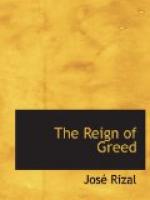Taking down from the walls several mirrors, he arranged them, turned them round and round, but, not getting the desired result, concluded: “As I say, it’s nothing more or less than a question of optics.”
“But what do you want mirrors for, if Juanito tells us that the head is inside a box placed on the table? I see in it spiritualism, because the spiritualists always make use of tables, and I think that Padre Salvi, as the ecclesiastical governor, ought to prohibit the exhibition.”
Padre Salvi remained silent, saying neither yes nor no.
“In order to learn if there are devils or mirrors inside it,” suggested Simoun, “the best thing would be for you to go and see the famous sphinx.”
The proposal was a good one, so it was accepted, although Padre Salvi and Don Custodio showed some repugnance. They at a fair, to rub shoulders with the public, to see sphinxes and talking heads! What would the natives say? These might take them for mere men, endowed with the same passions and weaknesses as others. But Ben-Zayb, with his journalistic ingenuity, promised to request Mr. Leeds not to admit the public while they were inside. They would be honoring him sufficiently by the visit not to admit of his refusal, and besides he would not charge any admission fee. To give a show of probability to this, he concluded: “Because, remember, if I should expose the trick of the mirrors to the public, it would ruin the poor American’s business.” Ben-Zayb was a conscientious individual.
About a dozen set out, among them our acquaintances, Padres Salvi, Camorra, and Irene, Don Custodio, Ben-Zayb, and Juanito Pelaez. Their carriages set them down at the entrance to the Quiapo Plaza.
CHAPTER XVII
THE QUIAPO FAIR
It was a beautiful night and the plaza presented a most animated aspect. Taking advantage of the freshness of the breeze and the splendor of the January moon, the people filled the fair to see, be seen, and amuse themselves. The music of the cosmoramas and the lights of the lanterns gave life and merriment to every one. Long rows of booths, brilliant with tinsel and gauds, exposed to view clusters of balls, masks strung by the eyes, tin toys, trains, carts, mechanical horses, carriages, steam-engines with diminutive boilers, Lilliputian tableware of porcelain, pine Nativities, dolls both foreign and domestic, the former red and smiling, the latter sad and pensive like little ladies beside gigantic children. The beating of drums, the roar of tin horns, the wheezy music of the accordions and the hand-organs, all mingled in a carnival concert, amid the coming and going of the crowd, pushing, stumbling over one another, with their faces turned toward the booths, so that the collisions were frequent and often amusing. The carriages were forced to move slowly, with the tabi of the cocheros repeated every moment. Met and mingled government clerks, soldiers, friars, students, Chinese, girls with their mammas or aunts, all greeting, signaling, calling to one another merrily.




